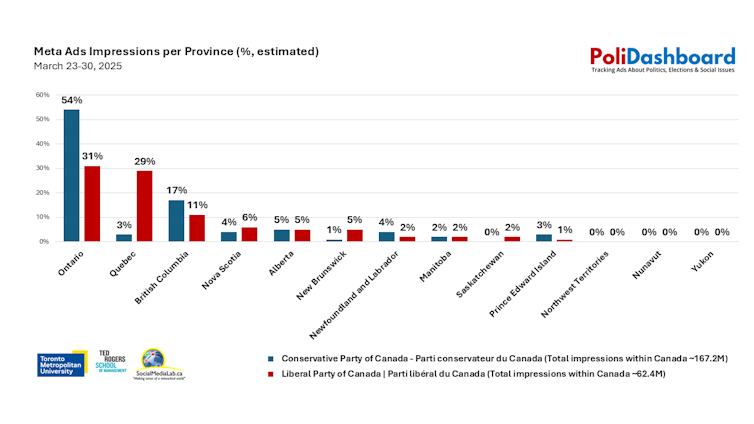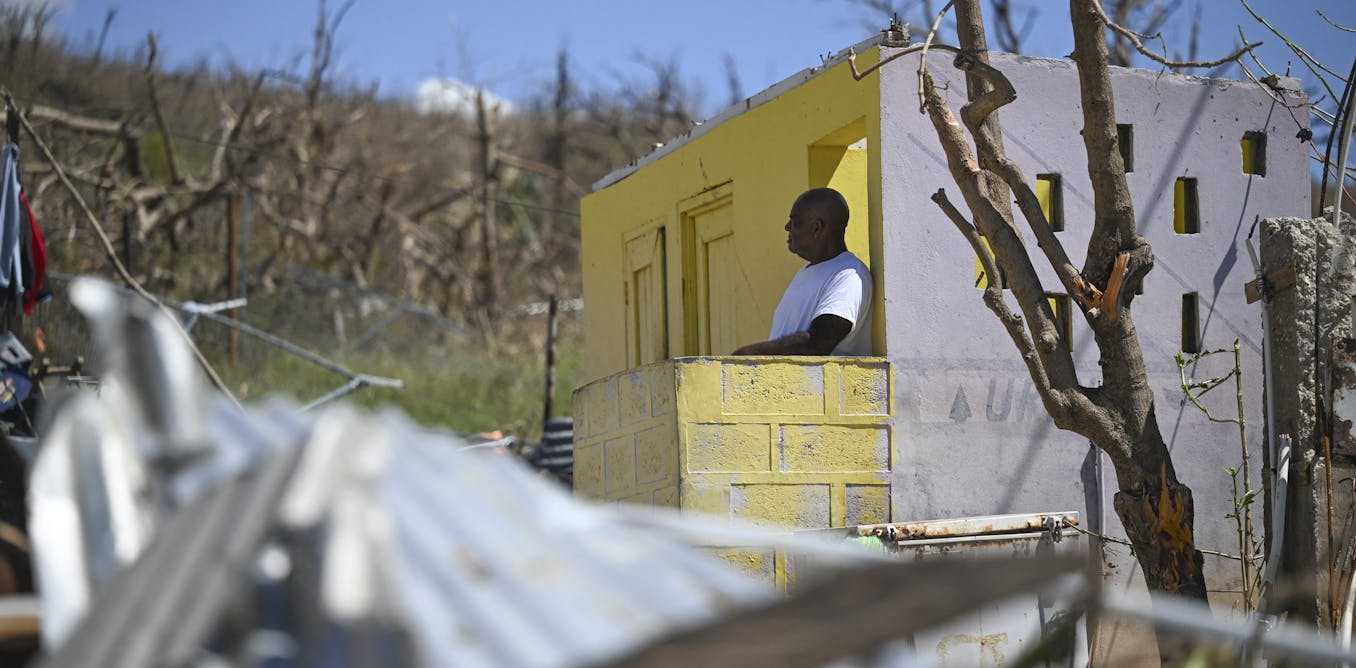Amid a Canadian federal election campaign focused in part on the country’s sovereignty, Canada’s two leading political parties are taking sharply different approaches to their advertising strategies. A close analysis of digital ad impressions on Facebook and Instagram reveals that the battleground is not just ideological, but demographic and geographic.
While both the Conservative and Liberal parties invest ad dollars in Canada’s most populous provinces, their strategies reveal a deeper story: Conservatives bet on Gen Z and Millennial voters, while Liberals double down on older voters and those in Francophone Canada.
We first observed these divergent strategies as part of an analysis conducted by the Ted Rogers School of Management Social Media Lab at Toronto Metropolitan University. As part of our Election Transparency and Accountability initiative, we examined Canadian political ad spending on Meta-owned platforms Facebook and Instagram, using PoliDashboard, the open-source platform we developed.
We conducted a detailed analysis of the ad impression data for the campaigns of all major parties. Here, we focus our findings on online ads purchased by the Liberal and Conservative parties, the current frontrunners in the polls.
Conservatives woo younger voters
Based on impressions data from Facebook and Instagram during March 23-30, the week after the election announced, there was a clear generational divide in digital outreach. The Conservatives devoted much of their messaging to Canadians under 45, while the Liberals appeared to focus more on those 55 and older.
A significant portion of Conservative Party Facebook and Instagram ad impressions came from men aged 25 to 34, who accounted for 16 per cent of all Conservative ad views. Additional impressions came from men aged 18 to 24, women aged 25 to 34, and women aged 35 to 44; each of these groups made up 10 per cent of the total impressions. This suggests an apparent effort by the Conservatives to connect with Gen Z and millennial voters.
In contrast, Liberal ads garnered higher impressions among older demographics, with women aged 65 and over accounting for the largest share (21 per cent) of total impressions. Women aged 55 to 64 and men over 65 each contributed 12 per cent of Liberal ad impressions. This distribution points to a strategic emphasis on older voters, a group known for reliably turning out on election day.
(PoliDashboard/Social Media Lab), CC BY
While traditional wisdom suggests that young adults favour progressive politics and parties, public polling suggests that young Canadians are increasingly embracing conservatism amid a housing and affordability crisis. The Conservatives appear poised to channel young peoples’ economic dissatisfaction into votes, using online advertising to reach them.
Meanwhile, the Liberals appear to be consolidating support among those who have a longer history of voting, especially older women, who represent the largest age and gender cohort that is likely to vote for the party. It’s a tale of two electorates, and two very different strategies for winning.
Impression data alone doesn’t confirm explicit age or gender targeting, nor does it guarantee support. Sometimes, a demographic simply has more affinity for a party’s content, leading to more impressions. These numbers can reflect both how parties aim their ads and how voters gravitate toward what resonates with them most.
Regional divides
The differences between the parties extend beyond age and gender, and into geographic territory. Both campaigns prioritize ad spending in Canada’s most populous provinces — British Columbia, Ontario and Québec — but the way they distribute their focus tells its own story.
The Conservatives receive a larger share of their ad impressions from British Columbia, with 17 per cent of their total ad impressions; in comparison, the Liberals received just 11 per cent. The contrast is even sharper in Ontario, where 54 per cent of all Conservative ad impressions are concentrated, versus only 31 per cent for the Liberals.
This difference is likely a deliberate strategic targeting tactic. Ontario, home to 122 federal ridings (with about 36 per cent of all seats in the House of Commons), is a pivotal battleground. The Conservatives’ strategy appears to hinge on flipping key seats in the province, particularly in suburban and outer suburban areas that could decide the election. Combined with their reach with younger voters, this approach signals an all-in effort to gain ground where it counts most.

(PoliDashboard/Social Media Lab)
The Liberal Party, meanwhile, is doubling down in Québec — one of the largest and most culturally distinct provinces in the country — and where the Liberals are clearly on the offensive. Twenty-nine per cent of Liberal ad impressions are located in the province, compared to just three per cent for the Conservatives.
Québec has long been a stronghold for the Liberals, particularly in urban areas like Montréal. While the province can be volatile and deeply influenced by local issues, the Liberals’ heavy advertising push suggests they’re working to defend the 33 seats they currently hold and possibly add a couple of new seats.
Two parties, two visions
Liberals and Conservatives are both vocally aligned in their repudiation of United States President Donald Trump’s frequent allusion to Canada becoming the “51st state,” a sentiment shared by an overwhelming majority of the Canadian public.
With external pressure mounting from Trump’s tariff threats and democratic norms being tested across the border, this election isn’t just about policies or parties: it’s about protecting Canada’s independence, values and place in the world.
However, the trends we’ve identified paint a picture of two distinct campaigns playing to different strengths and chasing different voters. The Conservatives are betting on young, digitally engaged Canadians, especially in Ontario. The Liberals are reinforcing their support among older voters, and looking to hold ground in Québec, where cultural identity and party loyalty still carry significant weight.
Of course, ad impressions are only one part of the equation. Factors like grassroots efforts, candidate appeal and regional dynamics also play a major role. Still, the ad impression numbers provide a unique glimpse into each campaign’s strategy, and reveal the part of Canada each party believes it must win over.

The post “Conservatives and Liberals are targeting different generations and geographies online” by Philip Mai, Co-director and Senior Researcher, Social Media Lab, Toronto Metropolitan University, Toronto Metropolitan University was published on 04/06/2025 by theconversation.com






































Leave a Reply